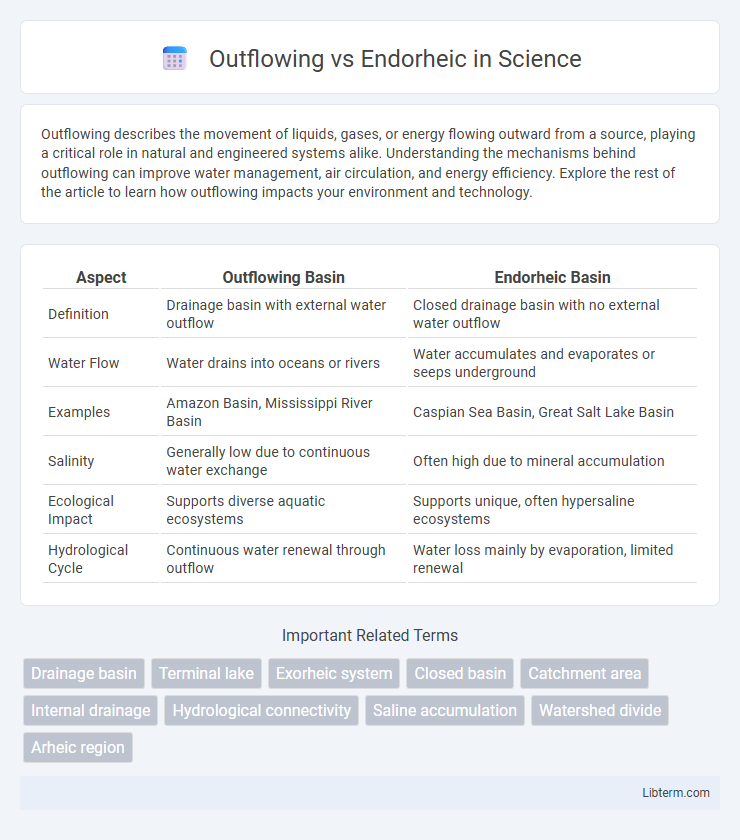Outflowing describes the movement of liquids, gases, or energy flowing outward from a source, playing a critical role in natural and engineered systems alike. Understanding the mechanisms behind outflowing can improve water management, air circulation, and energy efficiency. Explore the rest of the article to learn how outflowing impacts your environment and technology.
Table of Comparison
| Aspect | Outflowing Basin | Endorheic Basin |
|---|---|---|
| Definition | Drainage basin with external water outflow | Closed drainage basin with no external water outflow |
| Water Flow | Water drains into oceans or rivers | Water accumulates and evaporates or seeps underground |
| Examples | Amazon Basin, Mississippi River Basin | Caspian Sea Basin, Great Salt Lake Basin |
| Salinity | Generally low due to continuous water exchange | Often high due to mineral accumulation |
| Ecological Impact | Supports diverse aquatic ecosystems | Supports unique, often hypersaline ecosystems |
| Hydrological Cycle | Continuous water renewal through outflow | Water loss mainly by evaporation, limited renewal |
Introduction to Outflowing and Endorheic Systems
Outflowing systems are characterized by rivers and lakes that drain water toward the ocean, maintaining a continuous hydrological cycle through surface water discharge. Endorheic systems, by contrast, are closed drainage basins where water does not flow into the sea but accumulates in lakes or evaporates, creating unique ecological and chemical conditions. These distinct hydrological processes influence regional water balance, sediment transport, and biodiversity patterns.
Defining Outflowing Water Bodies
Outflowing water bodies are defined by their connection to external drainage systems, allowing water to exit via rivers, streams, or outlets flowing toward oceans or larger lakes. These water bodies maintain ecological balance by transporting sediments, nutrients, and organisms to downstream ecosystems, supporting biodiversity and nutrient cycling. Unlike endorheic basins, outflowing water bodies prevent salt accumulation by continuously flushing dissolved minerals through their outlets.
Characteristics of Endorheic Basins
Endorheic basins are closed drainage systems where water does not flow to external oceans or rivers, instead accumulating in lakes or evaporating within the basin. These basins typically exhibit high salinity and unique ecosystems due to limited water exchange and high evaporation rates. Common characteristics include arid or semi-arid climates, internal drainage, and the formation of salt pans or playas, distinguishing them from outflowing basins with external drainage outlets.
Global Distribution of Outflowing Rivers and Lakes
Outflowing rivers and lakes are predominantly found on nearly all continents, where they drain water towards oceans or seas, supporting extensive ecosystems and human settlements. Major outflowing rivers such as the Amazon, Nile, and Mississippi play critical roles in global hydrology, transporting freshwater across vast distances and influencing climatic patterns. In contrast to endorheic basins, which retain water internally with no oceanic drainage, outflowing systems contribute significantly to the global water cycle by maintaining continuous water exchange between land and marine environments.
Unique Features of Endorheic Systems
Endorheic systems are closed drainage basins where water does not reach the ocean but evaporates or infiltrates locally, creating unique hydrological and ecological conditions. These basins often feature saline or alkaline lakes due to mineral accumulation from evaporation, which distinguishes them from outflowing systems that connect to external water bodies. The isolation of endorheic systems fosters specialized biodiversity and sensitive environments vulnerable to climate changes and human activities.
Hydrological Cycle: Outflowing vs Endorheic
Outflowing basins contribute to the global hydrological cycle by draining water through rivers that empty into oceans or seas, maintaining a continuous flow of freshwater. Endorheic basins are closed drainage systems where water accumulates in lakes or salt flats, with no outflow to external bodies, leading to higher evaporation rates and unique salinity levels. The contrast between outflowing and endorheic hydrological processes significantly impacts regional water balance, ecosystem dynamics, and salinity gradients.
Ecological Impact and Biodiversity
Outflowing water systems, such as rivers and streams, support diverse ecosystems by facilitating nutrient flow, sediment transport, and migration routes for aquatic species, which enhances both local and regional biodiversity. In contrast, endorheic basins, with their closed drainage systems, often create isolated habitats that can lead to unique, highly specialized species but suffer from higher salinity and pollutant accumulation, impacting ecological balance. The contrasting hydrological dynamics result in outflowing systems generally promoting greater ecological connectivity and resilience, while endorheic systems exhibit fragile ecosystems sensitive to environmental changes.
Human Settlement and Economic Influences
Outflowing basins support extensive human settlements due to their reliable water discharge into rivers and seas, facilitating agriculture, trade, and transportation economies. Endorheic basins, lacking external drainage, often create saline or alkaline lakes, limiting freshwater availability and constraining large-scale agricultural development and dense population centers. Economic activities in endorheic regions frequently adapt to arid conditions, focusing on mining, salt extraction, and nomadic pastoralism rather than intensive farming or urban expansion.
Environmental Challenges in Endorheic Basins
Endorheic basins, characterized by closed drainage systems with no outflow to external bodies of water, face significant environmental challenges such as salinization, water scarcity, and pollutant accumulation. The lack of outflow results in higher concentrations of salts and contaminants, impacting aquatic ecosystems and reducing biodiversity compared to outflowing basins that have continuous water exchange. These environmental stresses in endorheic basins require targeted management strategies to preserve water quality and sustain local ecosystems.
Comparative Summary: Outflowing and Endorheic Water Systems
Outflowing water systems are characterized by rivers or streams that drain into oceans or seas, facilitating continuous water exchange and nutrient flow. Endorheic water systems contain closed basins where water accumulates and evaporates without external drainage, leading to high salinity and unique ecological conditions. The comparative dynamics between these systems influence regional hydrology, biodiversity, and water resource management strategies.
Outflowing Infographic

 libterm.com
libterm.com